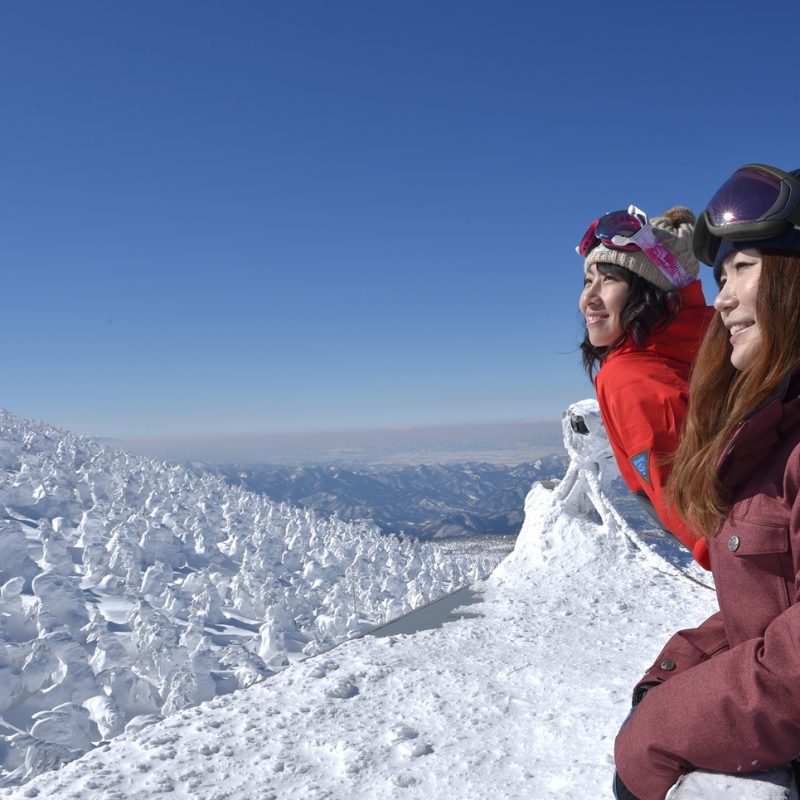LIVE IT UP WITH THE BEST SNOW VIEWING, INCLUDING THE WORLD-FAMOUS JUHYO
CONTENTS
Snow Resort Overview
Trail
The Juhyogen Course
Ohira Course
TAKATORI COURSE
Hanenkamm Course
Renraku Course
The Uwanodai Slope
Ryuzan Slope
Sunrise Slope
Chuo Slope
Diamond Valley
Paradise Slope
Shobunuma Slope
Kotan Slope
Nakamori Slope
Yokokura Slope
Hyakumannin Slope
Utopia Slope
Omori Slope
Kurohime Slope
Snow Monsters and Frozen Forest
SNOW MONSTERLIGHT UP
OVERVIEW OF ZAO ONSEN
KAMIYU PUBLIC BATH
Shimoyu Public Bath
Kawarayu Public Bath
Trekking Courses
Three Great Statues
Overview of Warabe no Sato
Shoya no Kura
Anzaisho
Zao Kokeshi Dolls
Accommodation
LOCAL SAKE & WINE OF YAMAGATA
TAMA KONNYAKU
JINGISKAN
YAMAGATA SOBA
YAMAGATA SAKE MUSEUM & YUKEMURI BAR TSUMAMI
The biggest charming point of Zao onsen is the famous ice monster in the world which made in the upper part of slope. Zao onsen village located in the foot of the mountains are originally traditional hot spring village where has long history as hot springs, not is made for ski resort.
Zao onsen is one of the most famous sulfur hot springs in Japan, there are 5 source group and 47 sources, and the biggest the scale in Yamagata prefecture. “Strongly acidic sulfur spring” is also known as hot spring for beautiful skin, and when you walk around this area, the smell of the sulfur e ect the atmosphere of the hot spring town. There are a lot of Japanese tra- ditional accommodations like a Japanese-style hotel/ RYOKAN, and a public bath and an outdoor hot spring bath also.
You can enjoy tasting the peculiar dishes, Mongolian barbecue/ Jingiskan, Tama Konnyaku and Yamagata Soba etc. Sake and the wine are also famous in this area. The biggest charming point for Zao is that you can be satisfied with travel and best hot springs as the fully combination.
The town of Zao is more than just an onsen and ski resort-all throughout Zao are marks of the town’s 1,900-year history. Near the center of town, for example, is a cluster of shrines located at the top of a long set of steep, narrow stairs. Stone lanterns line both sides of these treacherous stairs, and recently jokes have been written on them to entertain the weary and the elderly as they climb.
The city contains many small stone monuments. In order to facilitate new construction, five of these commemorative stones were moved to a single location. One of these is known as the Yuna Seki, or Yuna Stone. The Yuna Seki is said to commemorate the story of a man who died with his mistress, who was a bath-attendant or yuna (at the time, bath attendants were essentially prostitutes). His wife was distraught at their passing and built the stone statue of the yuna to commemorate them.
Most recently the town tourism board has erected stone pillars carved with Japanese traditional poetry (waka) written about Zao Onsen. These can be seen throughout the town, along with much older stone monuments. Some of these monuments have been standing so long that their inscriptions are weathered away.
Snow Resort Overview
While people have been coming to the Zao’s onsen for over a thousand years, the first ski resort opened on the mountain in 1925. One of the first resorts in Japan, Zao became popular for its beautiful powdery slopes of varying difficulty and for the Snow Monsters on the summit. The mountain is also home to some of Japan’s first ski lifts, the first of which was constructed in 1951. In all, Zao ski resort is equipped with over forty distinct trails and forty-one cable cars, ropeways, and ski lifts.
When you are on the mountain, please be aware that there are several kinds of trails with several levels of difficulty: Green trails are the lowest difficulty, easiest to access and to ski down. Red trails are intermediate and are intended for skiers of average ability. Black trails are for experts. Zao also has a competition-certified course, and night skiing is possible within certain areas of the mountain.
Please be aware that while the team at Zao wants every visitor to have the experience of a lifetime, the slopes are subject to certain rules: smoking is prohibited on all parts of the mountain, and regardless of your backcountry skiing experience, Zao is not a backcountry ski area. Do not go off-trail. Areas that look safe for off-piste skiing are likely to contain dangerous ravines. The ropeways and lifts are numbered and marked with multilingual signage. If you have any problems, Zao has a first-aid station and five ski patrol posts.
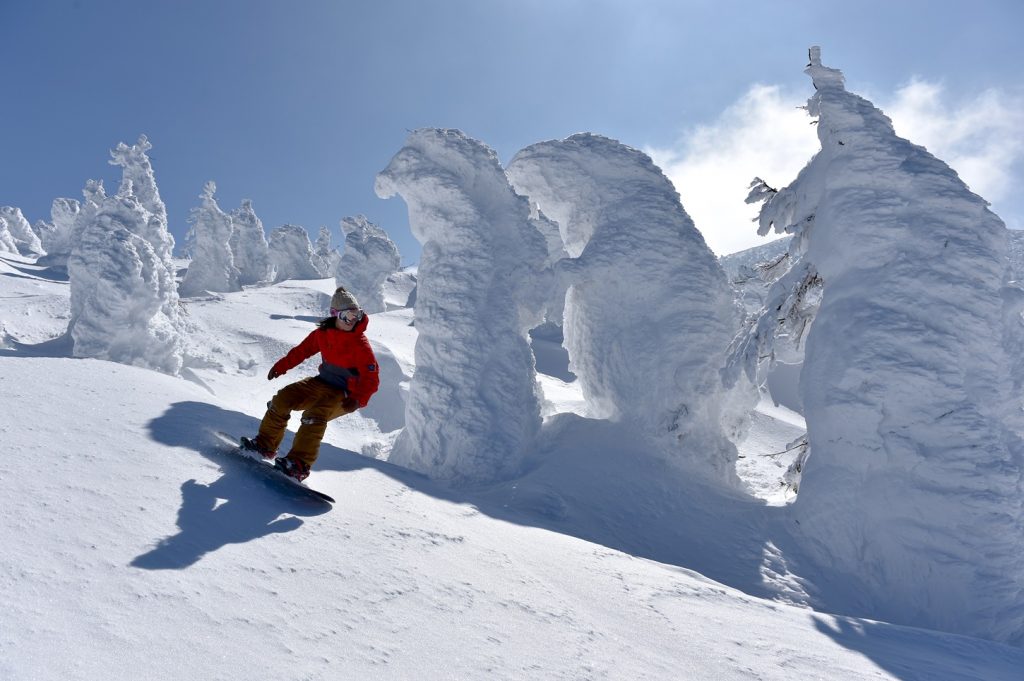
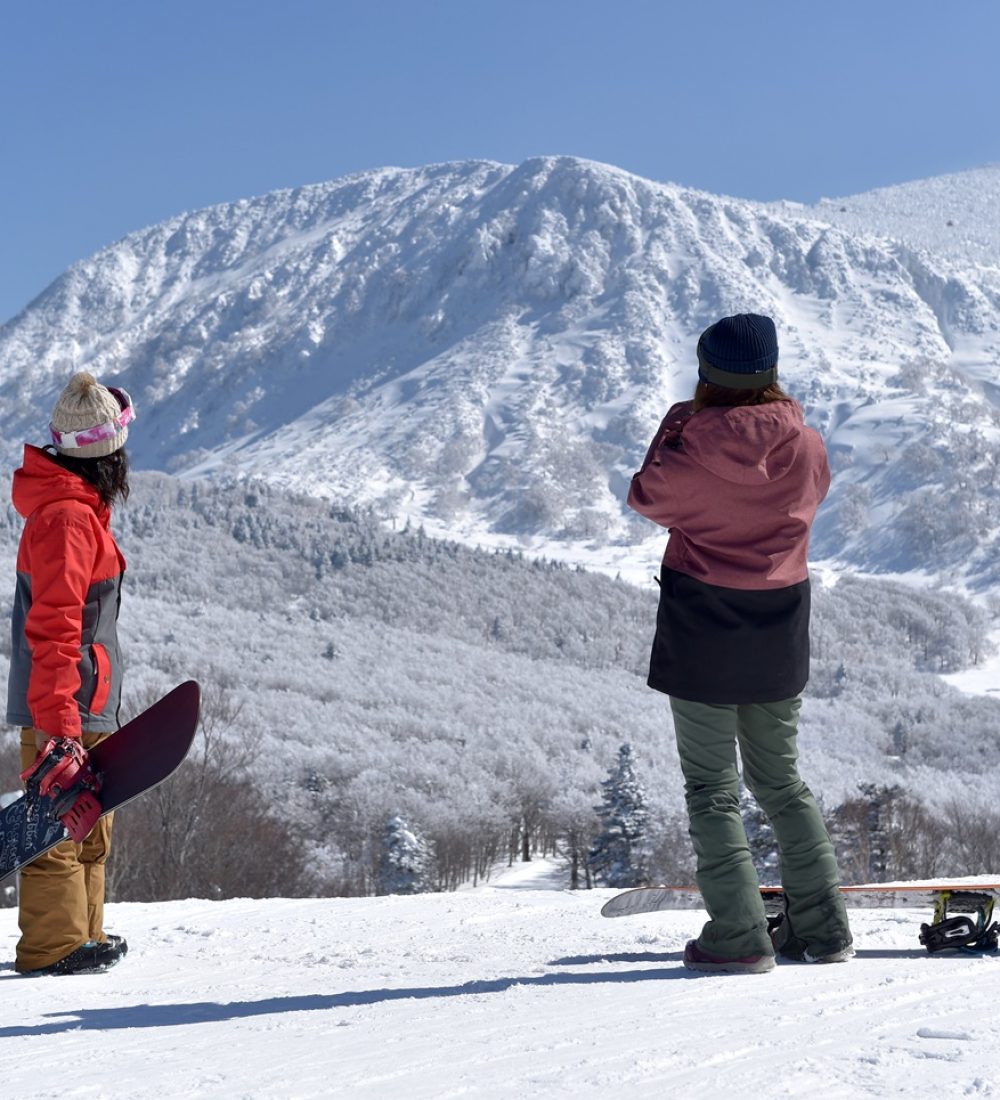
Trail
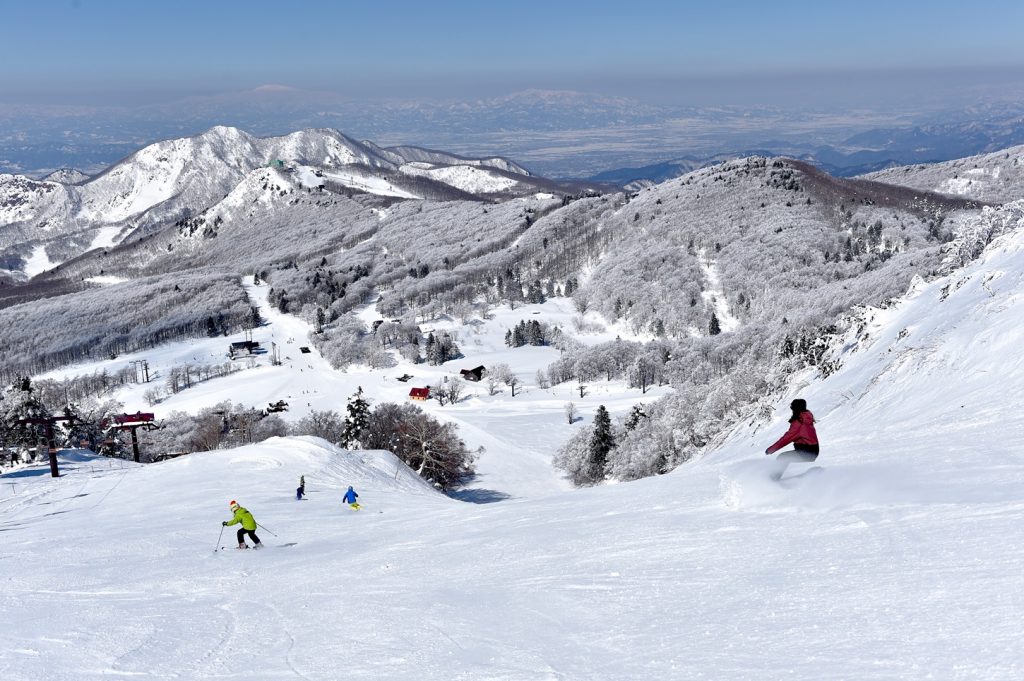
Zao Onsen is one of the most famous ski resorts in Japan. The altitude difference is 881 m. 14 slopes and 26 courses are satisfying not only for experts but also for intermediate level to beginner. Especially, everyone can enjoy the forest course slide comfortably. It is most recommended course where while enjoy sliding between the ice to ice spreading over the summit, you can watch the famous ice coating on the trees, after riding from Zao-Ropeway Sanroku line to Zao-Ropeway Sancho line.
The Juhyogen Course
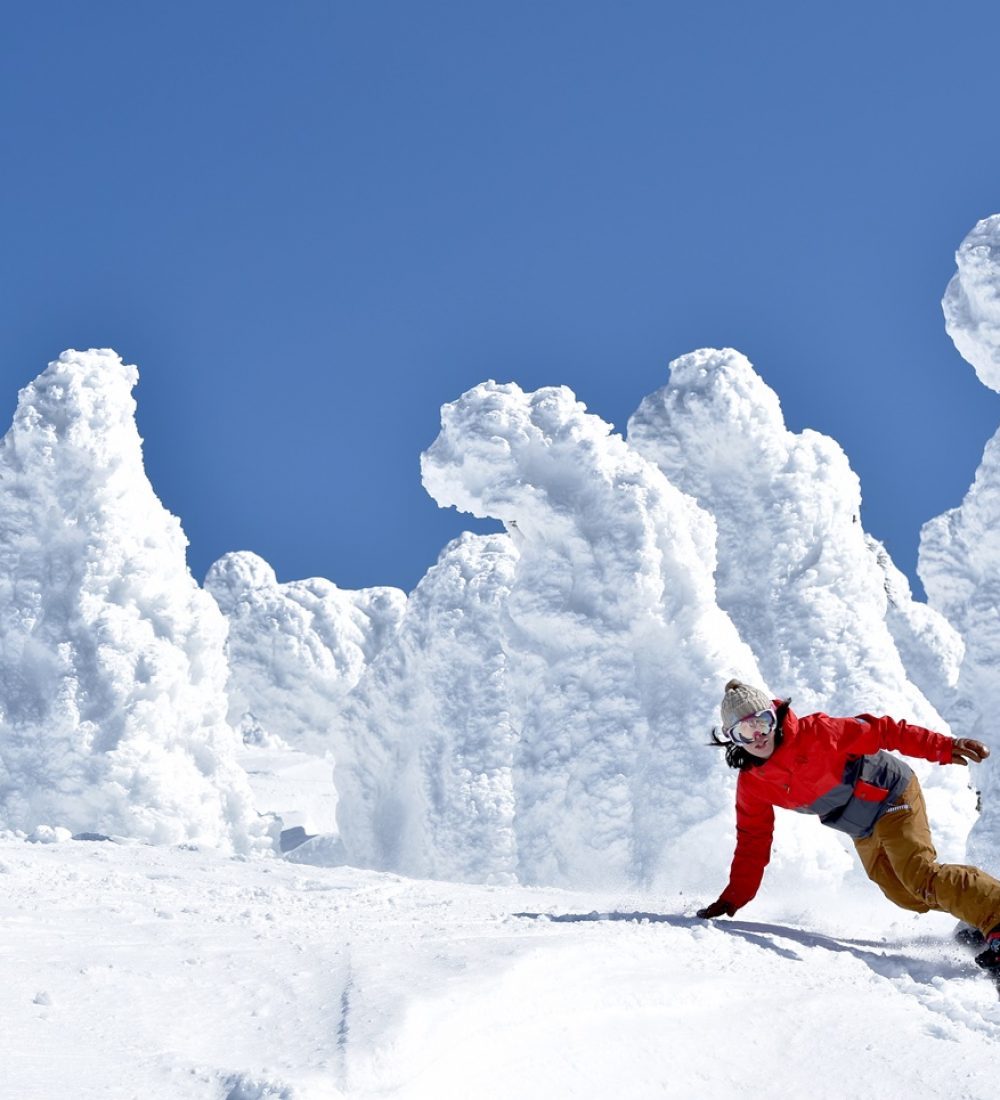
The Juhyogen Course is a red, or intermediate course. Also known as the Zange Zaka Course, the Juhyogen Course is the longest course on the mountain. Roughly ten kilometers long and starting from Jizo Sancho Station, this course first runs through two kilometers of Snow Monsters and then all the way down to Zao Onsen Village. From the upper-central part of the course you can turn into the Sailer Course, a red course with a steeper grade named for renowned Austrian skier, Anton “Toni” Sailer (1935-2009). Farther down the mountain, the Juhyogen Course will take you through the Utopia Slope and the Hyakumannin Slope to the Yokogura Slope near the bottom of the mountain. At first the gradient can be a little steep but should be no issue for beginners who are willing to snow-plough and take it slow.
Ohira Course
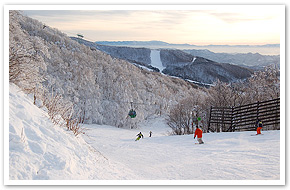
The Ohira Course is a green, or beginner course. The Ohira Course will be one of your first options after descending from either the Sailer Course or the Renranku Course. The Ohira Course is five kilometers long—the second-longest on the mountain—and will take you through the Paradise and Shobunuma Slopes to the Uwanodai and Sunrise Slopes. A central hub for the north side of the mountain, (the right side, from the skier’s perspective) the Ohira Course is wide (roughly thirty meters), and has some nice variation in grade, making it one of the more popular courses on the mountain.
Takatori Course

The Takatori Course is a green, or beginner course. Starting from the Chuo Slopes near the Zao Sky Cable Chuo Kogen Station, the Takatori Course is roughly three kilometers long. The course curves gracefully down past Diamond Valley, widening out as it reaches the bottom of the mountain. Please be aware the Takatori Course does transition into a red course with a steep 23° pitch when it reaches the Uwanodai Slope area, but the slope is wide enough that beginners should be able to easily control their speed with long hairpin turns.
Hanenkamm Course
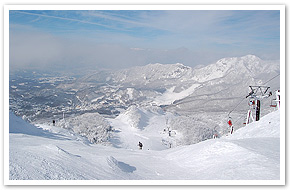
The Hanenkamm Course is a black, or expert course. Authorized by the FIS, Hanenkamm has A, B, and C courses, all of which end in the Uwanodai Slope area. A variety of competitions are held here throughout the year. The top of the A/B Course is a 38° wall that contains some of the most challenging terrain at Zao. The C course is to the north of the A/B courses (right, when facing down the mountain) and is a good course for both beginners and more advanced skiers. Heading south (left, when facing down the mountain) while going down Hanenkamm will lead you to the green Sunrise Course that you can take down to Zao Onsen.
Renraku Course

The Renraku Course is a green, or beginner course. It is a long, gentle course found at the beginning of the Utopia Slope that takes you across the mountain to the Shobunuma Slope. This narrow, kilometer-long course is popular with families because it has very gentle grade and good quality snow. The course connects one side of the mountain to the other, taking you from the Utopia Slope to the bottom of the Shobonuma Slope, where you can ride the lift up to the Paradise and Central Slopes and the Ohira Course, Hanenkamm Course, and Diamond Valley.
The Uwanodai Slope
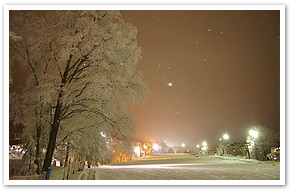
The Uwanodai Slope was the very first ski slope at Zao, and its ski lift was the second ever built in Japan. Almost anyone who has ever been skiing at Zao has been down this slope. Its light grade and proximity to the onsen town make it a popular place for lessons and for children. Also open for night skiing, Uwanodai is one of the most popular places on the mountain. You can get a hot meal, a new pair of gloves, or a rest at the Jupeer base center located at the bottom of the slope.
Ryuzan Slope
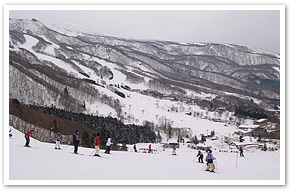
The Ryuzan Slope was the main slope used in the 1979 Interski training convention and is a green, or beginner area. Located next to the Kuraray Zao Schanze ski jump and with more than four different slopes to take down to the bottom, this is a great spot for families and beginners. It is a straightforward slope with little in the way of surprises and only minor grade variation between 20° to 23° throughout.
Sunrise Slope
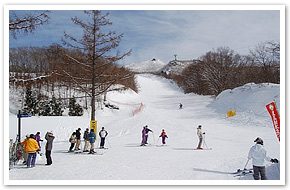
Located on the south side of the Uwanodai Course (to the left, from the skier’s perspective) the Sunrise Slope is split into two trails. The left trail has a sharp incline and is often used for pole practice, while the right trail is softer and better for beginners. The Sunrise Slope can also be used to access the Nakamori Slope via Kamoshika Obashi Bridge, which also leads to the Chuo Ropeway.
Chuo Slope
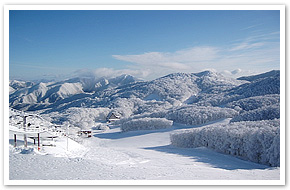
The Chuo Slope is one of the most popular slopes on the mountain. Covered with high-quality snow and looking out over the Snow Monsters, the Chuo Slope is a green, or beginner area. It is usually one of the first slopes to open each year and last to close for the season—during an average year, the snow on Chuo Slope will be skiable until around May. This central set of seven trails is a good starting point for beginners to get used to their gear before gliding down through Diamond Valley and the Frosted Forest. Chuo sits on top of the Hanekamm, Ohira, and Takadori Courses.
Diamond Valley
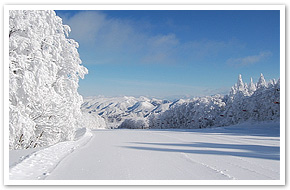
The Diamond Valley is a green, or beginner area. Right next to the Zao Sky Cable Chuo Kogen Station, Diamond Valley is the location of the Frozen Forest. On sunny days the sun shines through the ice on the trees, making them sparkle like crystal. The valley is a popular part of the mountain for group lessons because the snow is good, and the steepness of the slope varies between runs. The Takadori Course also cruises past Diamond Valley and straight down the mountain into town.
Paradise Slope
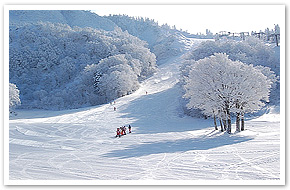
The Paradise Slope is a red, or intermediate area. Paradise Slope directly connects the Juhyogen Course to the Chuo and Uwanodai Slopes. Often full of thick, fluffy snow until Golden Week in May, Paradise Slope is right between the Snow Monsters and the Frosted Forest. It does have a rather steep 25° grade and is intended for intermediate skiers, but there is a more roundabout route with a gentler slope for beginners that ends at the same location as the wall. There is a free, sixteen-seat rest area near the lift building at the bottom of this slope.
Shobunuma Slope
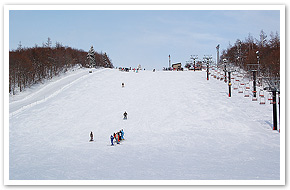
Shobunuma Slope is a green, or beginner area. This is a great area for those making their way down from the Kotan and Paradise Slopes. Shobunuma is one of gentlest slopes on the whole mountain and has a general grade of only 10°, which makes it a good place to give lessons to anyone trying skiing or snowboarding for the first time. The slope also has an area for tube sledding, and loudspeakers play music which can be heard across the slope.
Kotan Slope

The Kotan Slope is just north of the Paradise Slope (to the right, from the skier’s perspective) and has a beautiful panoramic view of the distant mountains. The two trails here are great for beginners and intermediate skiers who want to challenge themselves. Both courses are rated green but are more difficult than some of the other beginner courses on the mountain.
Nakamori Slope
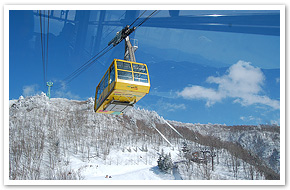
Most of the Nakamori Slope is a green area for beginners, but the top is for more intermediate-level skiers. The Nakamori Slope is near the base of the mountain and ends in front of Zao Chuo Ropeway Onsen Station. After taking the Triple Lift up to the third station, you can ski down Nakamori and across the Kamoshika Obashi Bridge to get to the Uwanodai and Sunrise Slopes. A Kids’ Area suitable for younger skiers is located at the bottom of Nakamori Slope as well.
Yokokura Slope

The Yokokura Wall, located at the very top of the slope, is known for its initially steep 38° incline, which is followed by 300 meters at a 30° incline. After clearing these two steep sections, this area is relatively straightforward, and beginner and intermediate skiers can take the longer slope around the wall to avoid them. The lower part of Yokokura is gentle and good for families. This slope is one of the two areas open for night skiing on the mountain. The Zao Ropeway at the bottom of the Yokokura Slope is also the main way to get to the summit to see the Snow Monsters.
Hyakumannin Slope
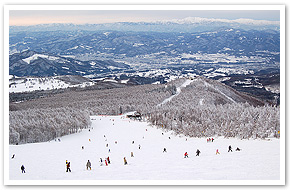
Some parts of this green slope, located in the Juhyogen Course, are 200 meters wide, making the slope popular with beginners. It offers grand views and is perfect for families and groups who want to ski together. Some instructors will also bring classes here to take advantage of the open space. Hyakumannin is connected to the Kurohime, Omori, Yokokura, and Utopia Slopes.
Utopia Slope
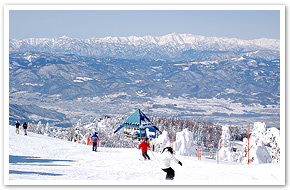
As the name suggests, the Utopia Slope is a green, or beginner area. Right in the middle of the Juhyogen Course, this slope is located in front of Zao Ropeway Juhyo Kogen Station and offers moderately challenging skiing, fantastic powder, and spectacular views. The restaurant Todomatsu is a great place to stop and take a break. Utopia is up the mountain from the Kurohime and Hyakumannin Slopes, and when facing downhill the Renraku Course is further north (right from the skier’s perspective) on the mountain.
Omori Slope
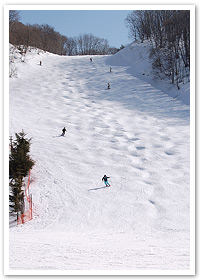
The Omori Slope is a multilevel area, the lower level of which is intended for younger skiers. The long course starts near the top of the Yokokura Wall and is serviced by the Omori Quatro four-person ski-lift. The Omori Wall at the end of the course is good for experts. It is very steep, with a maximum pitch of 30°, and contains moguls. The other trails range in difficulty, so visitors should pay close attention to trail signs.
Kurohime Slope
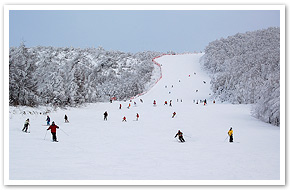
The Kurohime Slope contains beginner, intermediate, and expert trails. Kurohime is the southernmost slope on the mountain, beginning at the top of the Kurohime Quatro Lift No.1 and connecting in four different places to the Hyakumannin Slope. The main trail is 1.7 kilometers long with a maximum grade of 26°, but it diverges into the more difficult Super Giant Course, which is intended for intermediate skiers, and the Crazy Traverse Course, which is for experts.
Snow Monsters and Frozen Forest
On a clear day at Zao, when the ski conditions are at their best, the mountain’s ropeways and ski trails fill with locals and travelers alike. From the Jupeer Base Center to Jizo Sancho Station at the peak, skiers and boarders of many ages and skill levels are everywhere. But when the sun has just begun to climb in the sky and the trails have not yet become packed with figures in parkas and snowpants, visitors can share a quiet moment with the towering pack of imposing white figures that amass on the southern slope—the famous Snow Monsters of Zao.
The Snow Monsters (or Ice Monsters) are called juhyo in Japanese. The word means “frost-covered trees,” but when you’re up close, walking or skiing among them, nothing so benign comes to mind. They seem to stomp across the landscape, beautiful and otherworldly. The juhyo are Maries’ Fir trees that have been transformed by the dry winds of the Siberian desert. These winds sweep across the Sea of Japan, rolling over the peaks of the Asahi mountain range and passing over the Shirataka Hills and Yamagata Basin before releasing super-cooled droplets of rain that do not freeze even at several degrees below zero. The Snow Monsters of Zao are born when these droplets meld with the snow on the mountain. The Snow Monsters do not last very long, and they have been shrinking in size and number due to global climate change, but they are still a sight to behold. They are at the apex of their growth between late January and mid-March.
Located farther down the slopes, the Frosted Forest (muhyo chitai) is a silver grove filled with wind-whipped ice. This silver frost is formed when condensed water vapor is exposed to freezing air. Dew on the stems of grass and leaves is caught in a slow freeze. Swept together, the dew becomes translucent ice that refracts the light like silver filigree. Like a garden of glistening timber chrysalises, the Frosted Forest is most picturesque around the same time that the Snow Monsters become most imposing. Both are easily reachable from the main Juhyogen Course and can be reached by skiers of any level. The mountain is serviced by several ropeways, and the view from these is a wonder in its own right. The condition of both the Frozen Forest and Snow Monsters may vary depending upon weather conditions, but the best time to view them is during the colder hours of the morning.
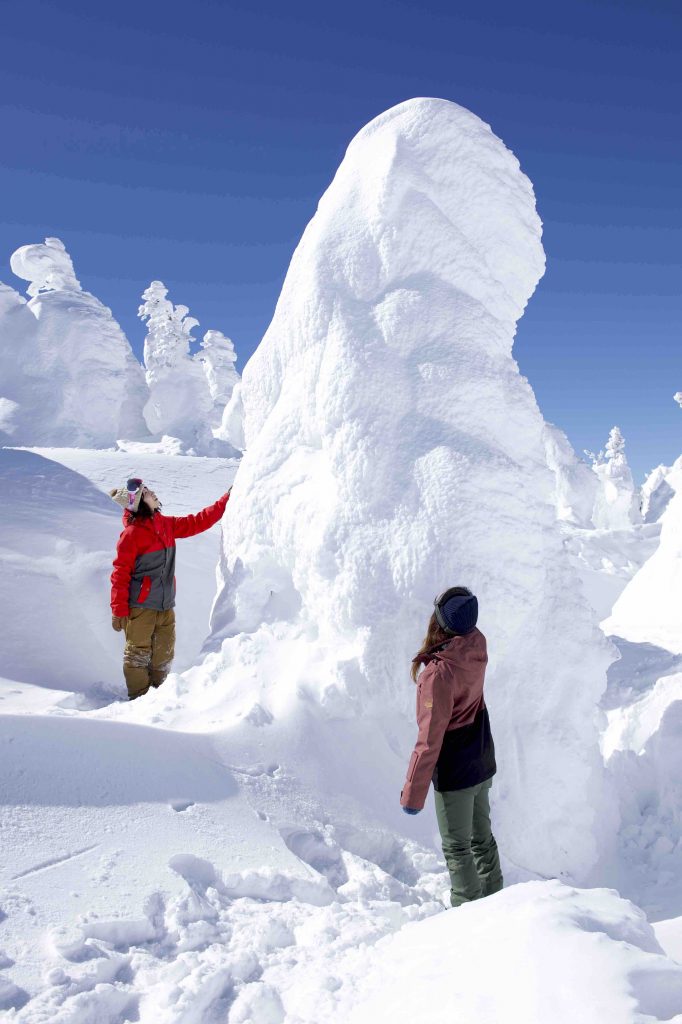
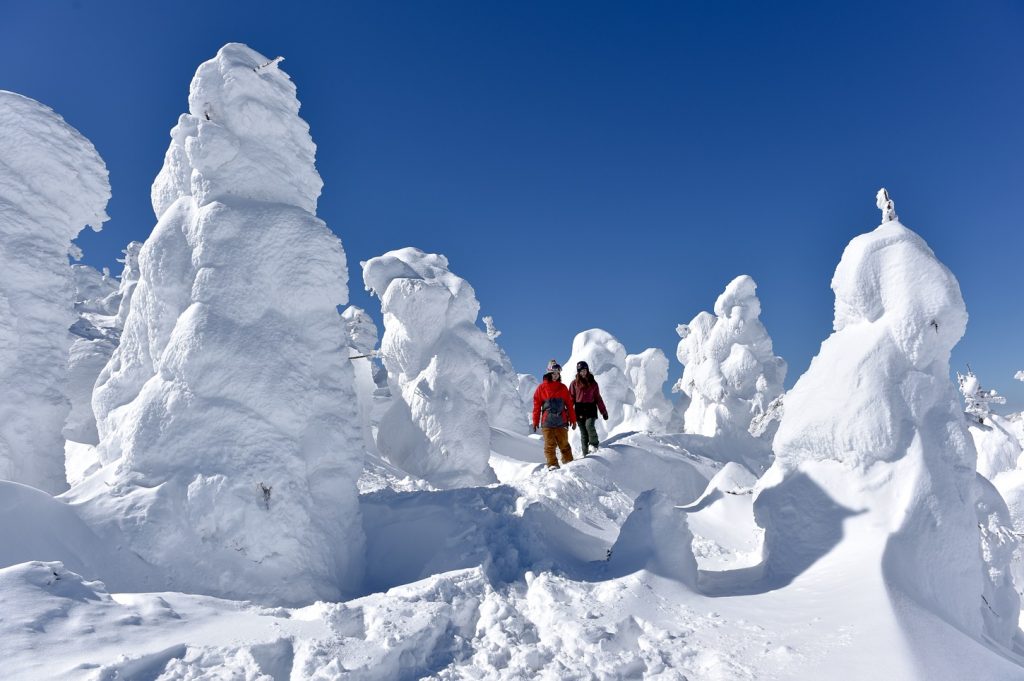
-1024x739.jpg)
Snow Monster
light up
At night, you can see the lighted up JUHYOU/Snow monster from the Ropeway at the Mountain Top station observatory. The fantastic scene of colorful JUHYOU which floats in the dark is masterpiece!


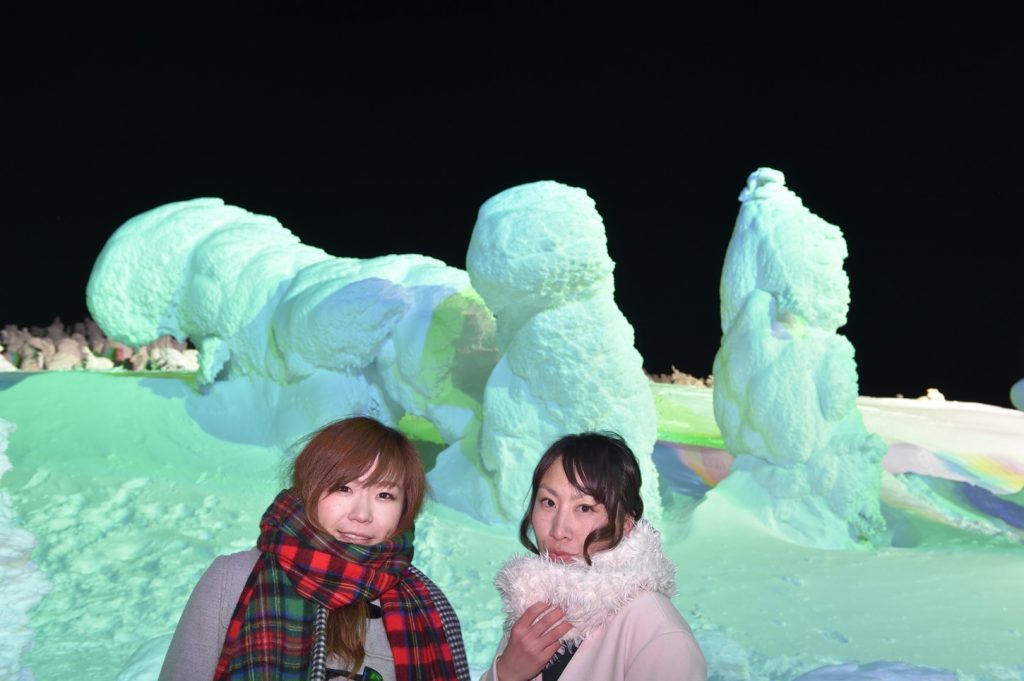
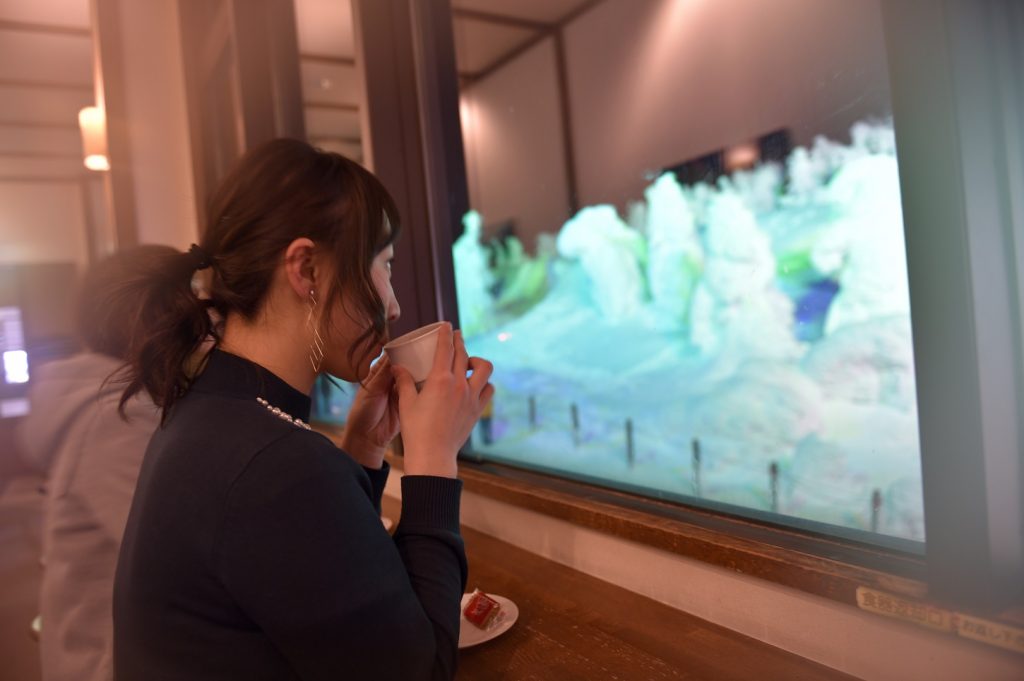
Overview of Zao Onsen
There have been humans on Mount Zao for at least 1,900 years. While the onsen town’s beginnings are uncertain, the properties of its waters are well known. Therapeutic and invigorating, with names like “springs of beauty,” these hot springs brought an influx of tourism in the early 1900s. The water of Zao Onsen is very acidic, with a pH range between 1.6 and 1.25. This acidity offers a variety of medicinal benefits, but it will also oxidize and discolor metal, so visitors should take care with any jewelry or piercings. Zao has three famous hot springs, all of which are open to the public for a small donation of 200 yen.
As these springs are very old, traditional facilities, it is important to know the correct behavior for visiting one. The hot springs are separated: one side for men (男), and one side for women (女). Visitors must bathe before entering the bathhouse. There is no space to wash in the bathhouse itself and entering a communal bath without washing is considered impolite. Towels are not worn into the water; some bathers place their towels on top of their heads but leaving it by the edge of the bath is also fine. Smoking or roughhousing within the baths is also prohibited. Because of their association with crime, tattoos are considered taboo within Japanese society, and visitors with tattoos are asked not to enter the bath.
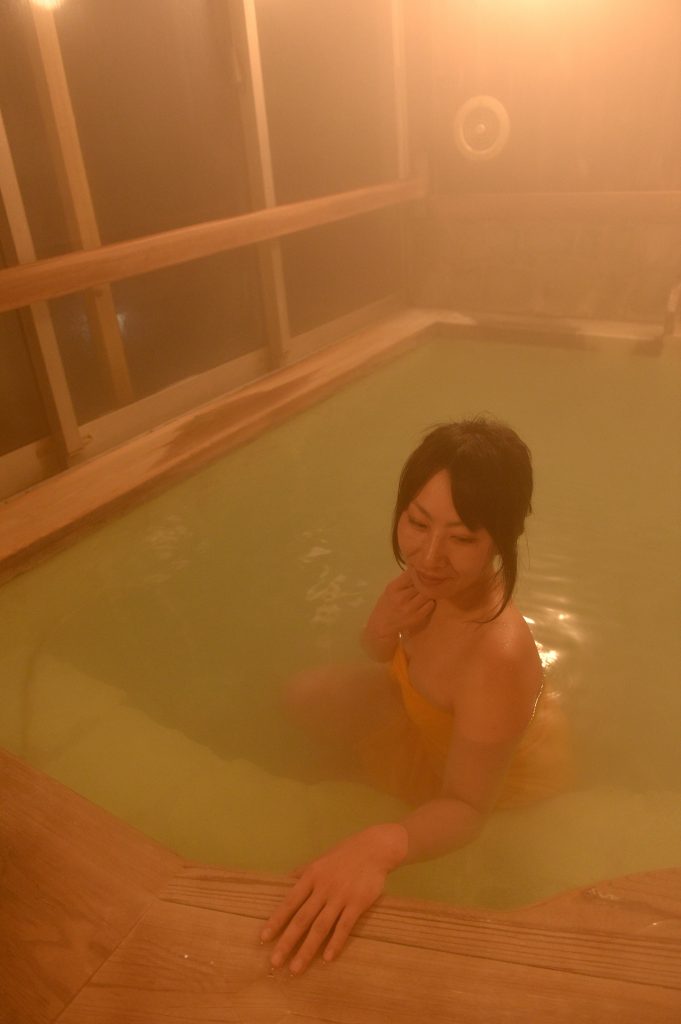
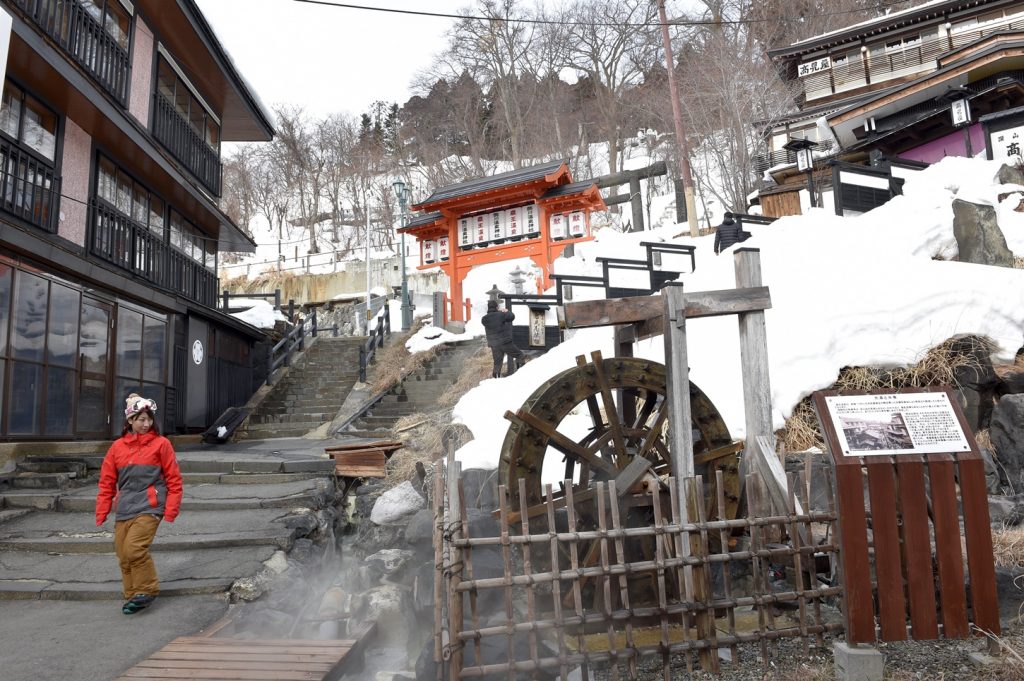
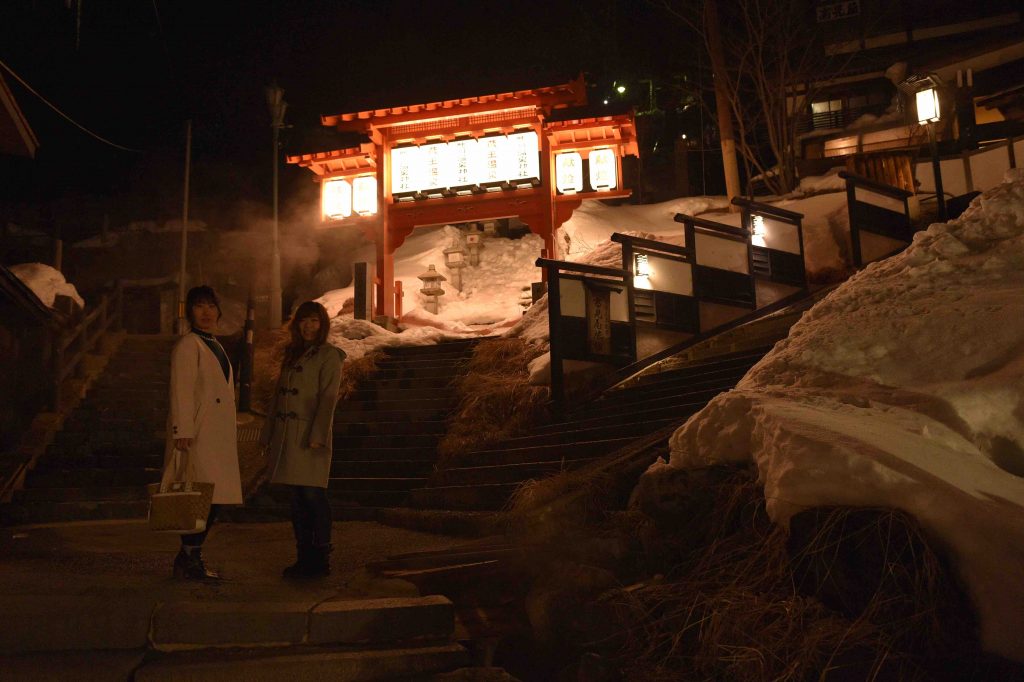
Kamiyu Public Bath

According to local legend, people have been visiting Zao since 110 CE. The hot springs are believed to have been discovered by soldiers who were sent to find cherry blossoms. A local ruler was shot with a poisoned arrow, and as he lay dying, he asked his retainers to bring him a sprig of cherry blossoms so that he could see their beauty one last time. His retainers went into the nearby hills and mountains to search for a cherry tree. Cresting a ridge, one of the retainers was caught off guard by what looked like smoke from the cookfire of an enemy camp. He went to investigate and discovered not a fire but a hot spring with bubbling waters. The retainer brought his lord to the pool and watched in wonder as his master was healed upon entering the water. So goes the story, but whether the life-saving properties of the water are true or not, there is no doubt that Kamiyu public bath is the spring it describes, the source of the hot spring water in Zao.
◆Opening period / all year long
◆Opening hours / 6:00-22:00
Shimoyu Public Bath
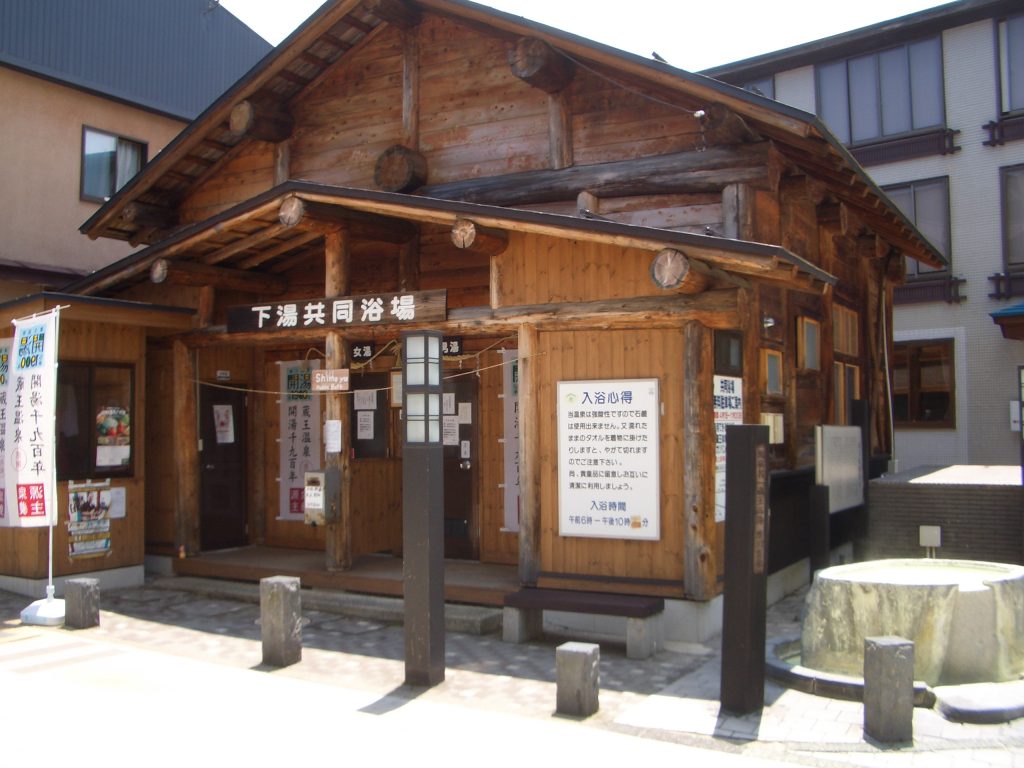
From the latter part of the Edo period (1603–1868) Zao Onsen became a tourist destination for the surrounding domains. Believing its water to be a panacea, people came to Zao to be healed of their ailments. They stayed at the inns (ryokan) that make up much of the town and bathed in the waters. By the 1860s the Kamiyu bathhouse had become too crowded, and the town built the Shimoyu public bath lower down the side of the mountain. Outside the Shimoyu building are a stone monument and footbath which the same water as the bath inside. To prevent discoloration, visitors should be sure to remove any jewelry before putting their hands or feet in the bath waters.
◆Opening period / all year long
◆Opening hours / 6:00-22:00
Kawarayu Public Bath

Kawarayu is a free-flowing onsen, which is extraordinarily rare. Although normally onsen are filled with spring water that is piped in from elsewhere, this bath is built on top of a depression in the bedrock where the water from higher up the mountain flows down and gathers naturally. Open slats in the sides and bottom of the basin allow the spring waters to flow freely through the bath.
Like the Kamiyu and Shimoyu baths, the water temperature at Kawarayu bath fluctuates but can reach temperatures of up to 50° C. Visitors should enter the bath slowly to give themselves time to adjust to the heat, and once submerged, hold still to let their muscles fully relax. Bathers should refrain from splashing and supervise their children. There is no specific rule regarding the age at which children can enter the hot springs, but there is a risk of heatstroke for any child younger than four years old.
◆Opening period / all year long
◆Opening hours / 6:00-22:00
Trekking Courses
Zao is fantastically beautiful during the winter, but that beauty is not limited to the months when the mountain is covered in snow. Some of the ropeways run year-round, and the mountains become especially beautiful for hiking during the summer and fall. Some noteworthy attractions include Okama Volcanic Lake, Fudodaki Falls, and Zao Quasi-National Park.
Please note the following safety information for visitors to the park outside of the ski season:
When visiting Zao during the warmer seasons, bring plenty of water (1.5–2.0 liters per person), dress appropriately for the weather (rain gear, even if rain isn’t in the forecast), and inform someone, such as the hotel staff, of your route and destination as well as your intended return time. When hiking, you must stay on the trail—do not attempt to make your own route up the mountain—and respect the wildlife. Hunting, fishing, and collection of specimens are not allowed. Likewise, leave no trace of your presence on the mountain. Please keep in mind that camping is allowed only in designated areas.
While hiking, it is important to make noise to alert the local wildlife to your presence, as startled animals are more likely to pose a threat. A bear bell, which can be strapped to your pack and will make noise as you walk, makes a good souvenir. If you do encounter a bear, make sure you know how to keep yourself safe: if you are in a group, make as much noise as you can; if alone, do not run. Instead, back away slowly. Bear attacks are rare, but if attacked by a black bear, fight back using anything you may have and with everything you’ve got. If possible, aim for the eyes and nose.
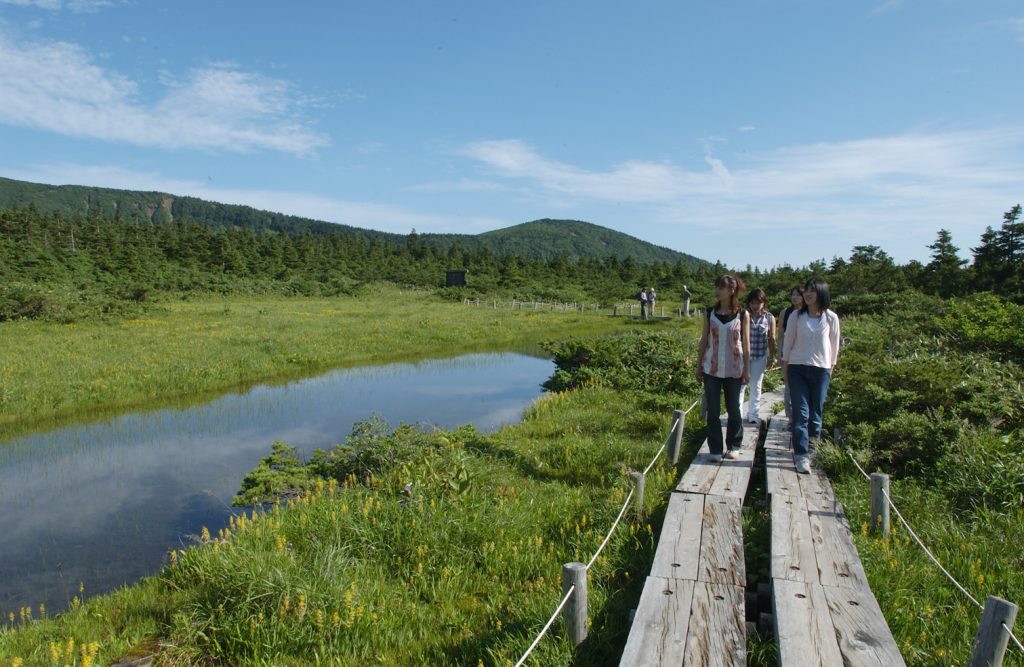
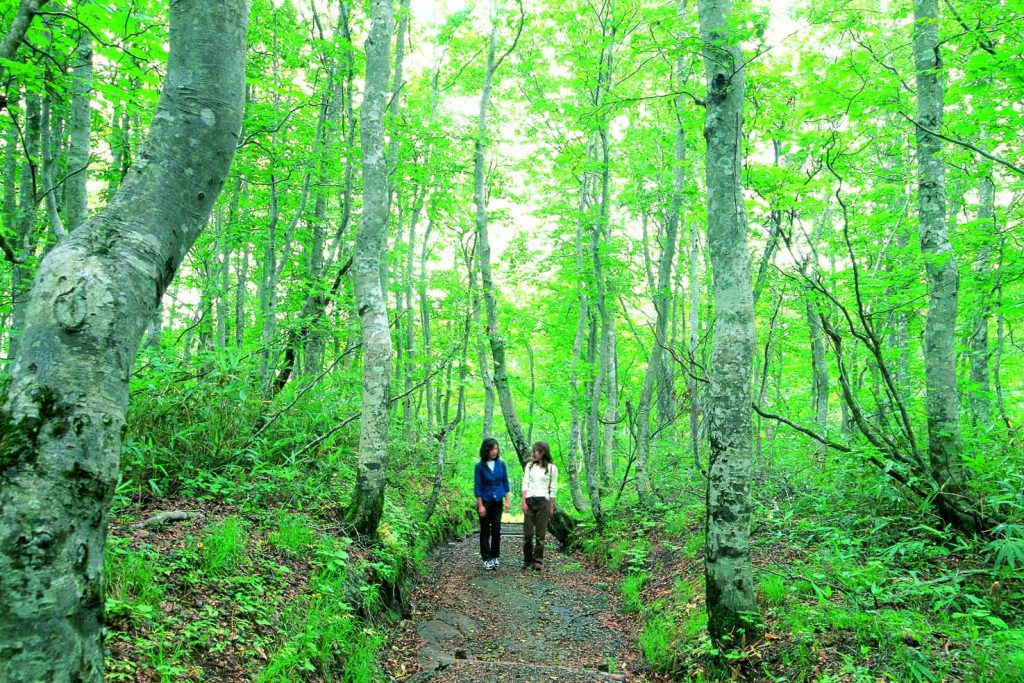
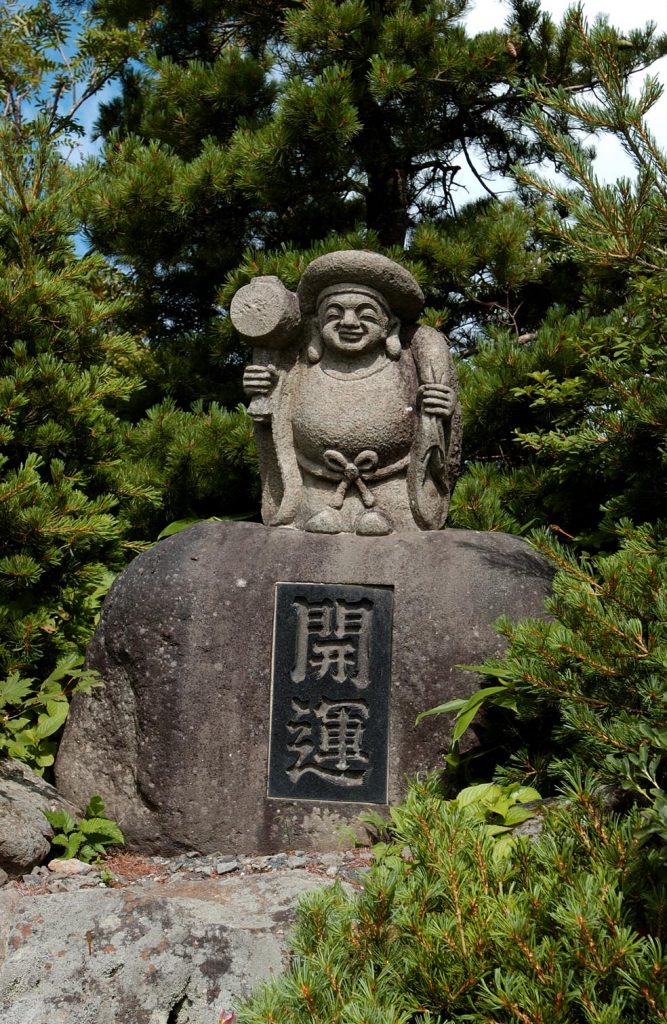
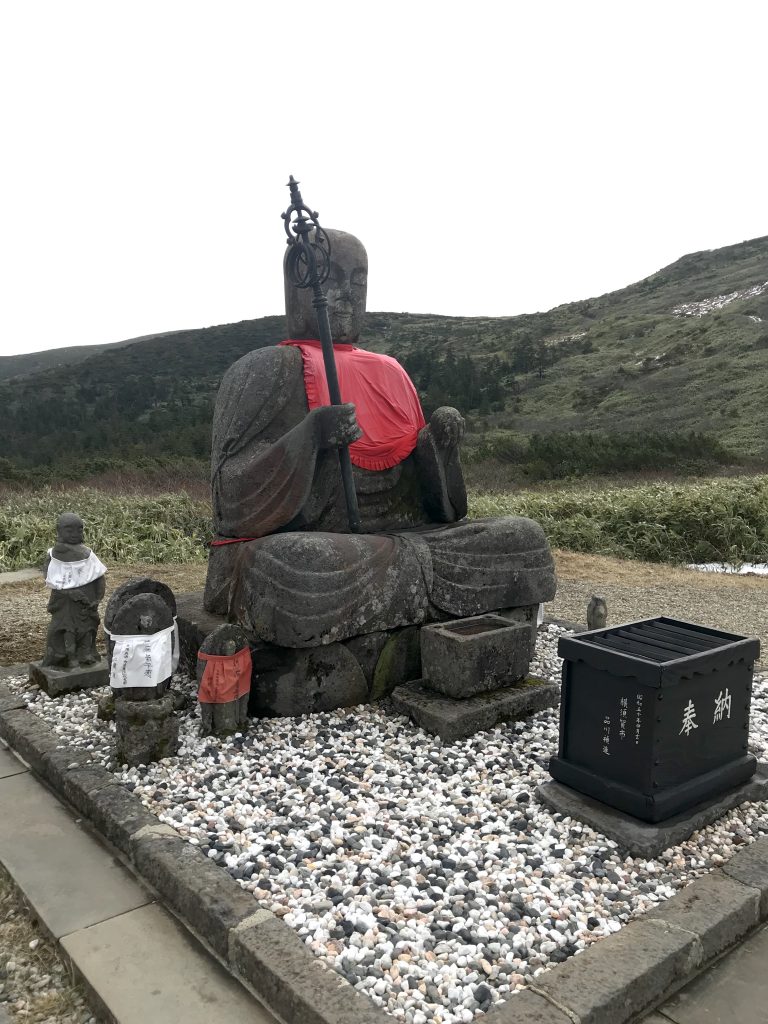
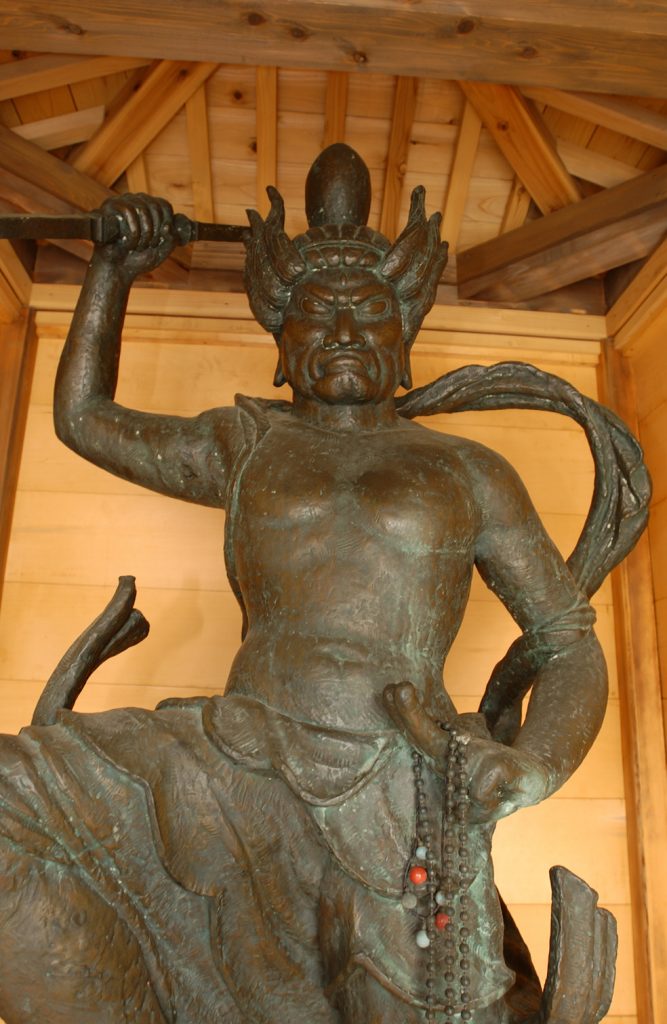
Three Great Statues
Three large statues of the gods Jizo Son, Daikokuten, and Daigongen were built on Zao to protect the people who live on the mountain. “Jizo Son” is the Japanese name of the bodhisattva Khitigarbha, who is revered in Japan as a protector of children. The Zao Jizo Son was built in 1775 and is easily accessible by the Zao Ropeway, but during the winter only the statue’s head is visible above the snow.
Zao Daikokuten can be found near Outlook Point at Torikabuto Station. The statue was erected in 1980 for the safety of visitors to Zao and the continued health of the tourism economy. Zao Daigongen was erected in 2002 near Chuo-Kogen Station. Daigongen is the deity who keeps the town safe from disaster and maintains peace throughout the year.
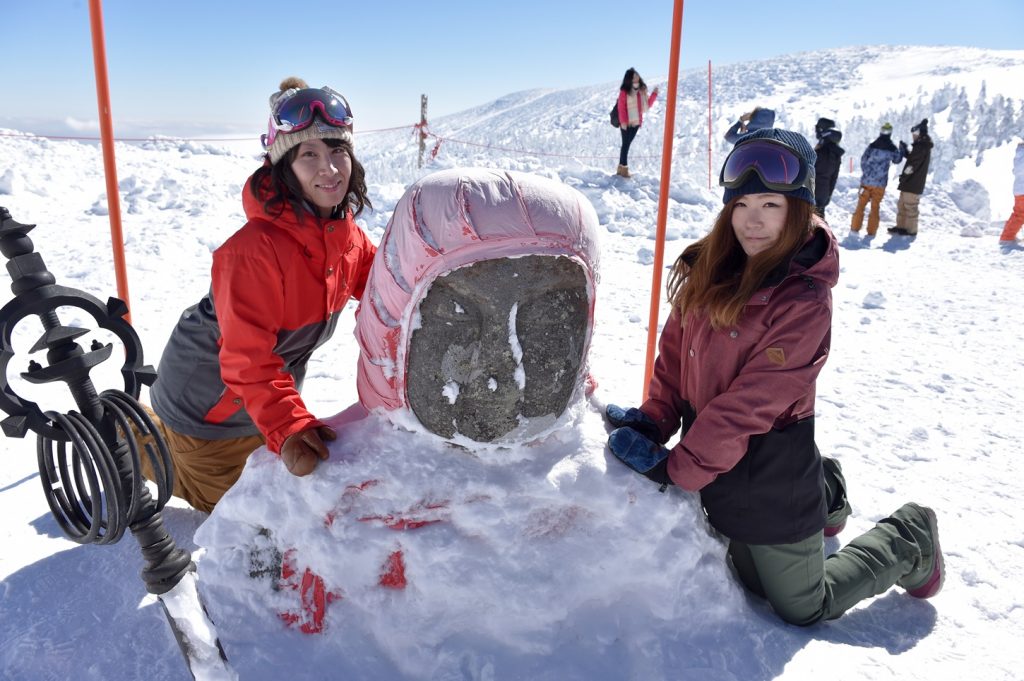
Overview of Warabe no Sato
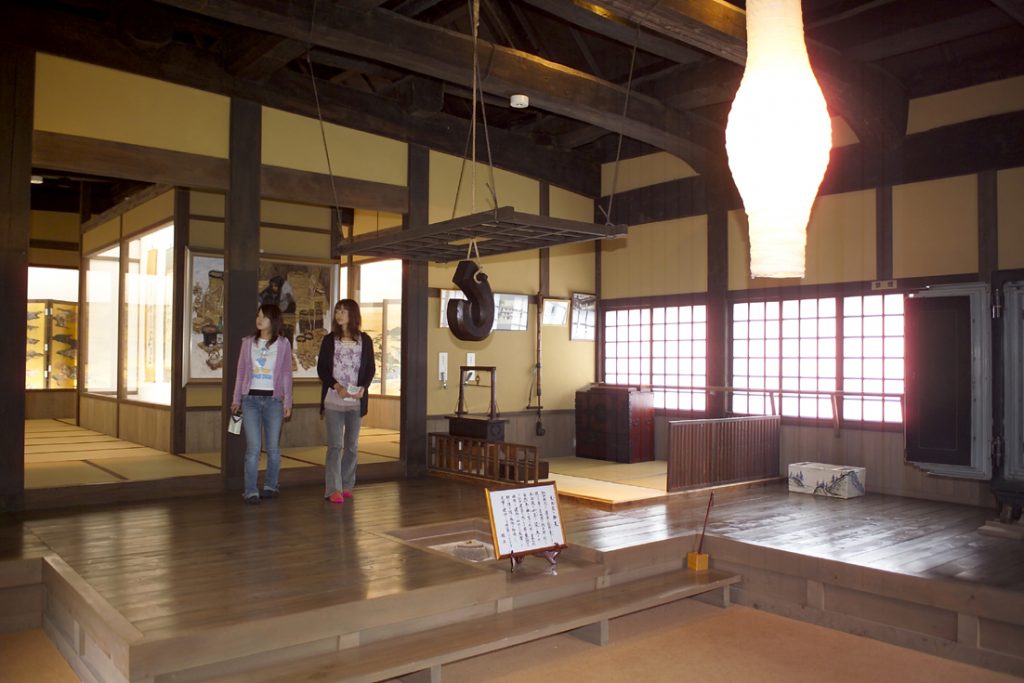
Warabe no Sato is a museum comprising five historic buildings filled with mostly art and artifacts from the Edo period (1603–1868). The museum is run by the Takamiya Hotel Group, which also operates a 300-year-old ryokan in northeast Zao. The many beautiful objects on display at Warabe no Sato museum give a clear image of the lives of the wealthy during the Edo period (1603–1868), and many of the pieces stored here once belonged to the local daimyo. The buildings themselves are also historical treasures, and several were relocated to the site from other areas. Two of the buildings are from Miyagi Prefecture, and a few of the other of buildings were moved here from Yamagata city.
In addition to a large collection of art pieces, the museum has a number of items used by various visiting dignitaries. One of the houses in the complex, originally built for the visiting Emperor Meiji (1852-1912), has been remarkably preserved with the original decorations still on display. Visitors to Warabe no Sato can expect to learn a lot about the history of Yamagata and the Takamiya Ryokan that runs the museum. The museum is open from 9:00 am to 5:00 pm, and entry is 700 yen.
Shoya no Kura
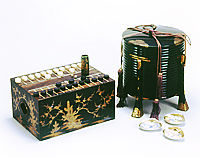
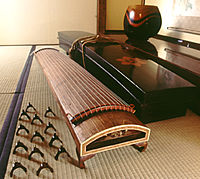
North of the main building and storehouse is a restored rice warehouse from the Goto Matabei Ryokan that originally stood in Yamagata city. The two-story building is now used to showcase beautiful and intricately crafted Edo-period (1603–1868) goods including a princess’s toys, combs, and wedding kimono. At the time, the kimono was said to have been so well made that the finest weavers from Kyoto were unable to reproduce the gold filigree woven into it. Upstairs are even more amazing artifacts. Even the steps are unique—it is common for traditional two-story Japanese buildings to have cupboards built into the stairs, but instead of being removable from the side, the cupboards open directly over the flats of the stairs. On the second floor, there are over one hundred and twenty ivory netsuke, miniature carvings that are used to attach a pouch to the belt of a kimono. Also on display are poems written by famous poets during their stays at the inn, and a daimyo clock, which tells time in the traditional Japanese system that was used during the Edo period (1603–1867). The main support beam for the roof is made from a single piece of Japanese red pine, a notoriously gnarled species of tree whose twisted shape is popular for bonsai. A straight beam of this size is remarkable, and indirectly shows the wealth associated with the construction of this inn.
Anzaisho
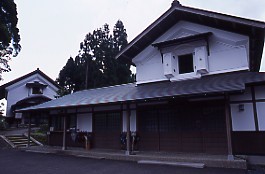
This building took ten years to complete and was used for only 30 minutes. Construction began in 1882 to accommodate Emperor Meiji (1852-1912) during his travels in northern Japan. The house was finished in 1892, and the emperor finally came to visit in 1909. The lodgings were built by the Hanzawa family to entice the emperor to stay at their home rather than a government building. The entire house is believed to have been built from the wood of a single tree. The windows are over one hundred years old, and still have their original glass fittings. The rooms are divided by painted sliding doors (fusuma), and the floors are raised to different heights for different levels of dignitaries. Accordingly, the highest room was reserved for the emperor himself. Although it may seem extreme, the Hanwaza family’s work was not in vain: the emperor reportedly relaxed here for a brief time before moving on.
Zao Kokeshi Dolls
Kokeshi dolls are a common souvenir from northern Japan. The first known kokeshi is thought to have been made in Togatta Onsen near Zao, and the practice spread to Zao and other onsen towns in northeastern Japan during the Meiji era (1867–1912). The dolls are traditionally children’s toys and were bought as gifts by visitors to the onsen. Handmade from wood, kokeshi come in many sizes but are generally of a single characteristic shape: a simple trunk for a body and a spherical head. They became popular with collectors during the twentieth century, and kokeshi-makers began to sign their work. Despite their simple shape, making a kokeshi is not easy. After the wood is harvested, it must be left to dry for one to five years before it can be used, after which it is carved on a lathe. Depending on the style, the dolls will either be made of one or two pieces of wood, and their decorations reflect the locations in which they were made. Sadly, only a few kokeshi artisans still live in Zao, and this tradition may soon disappear.
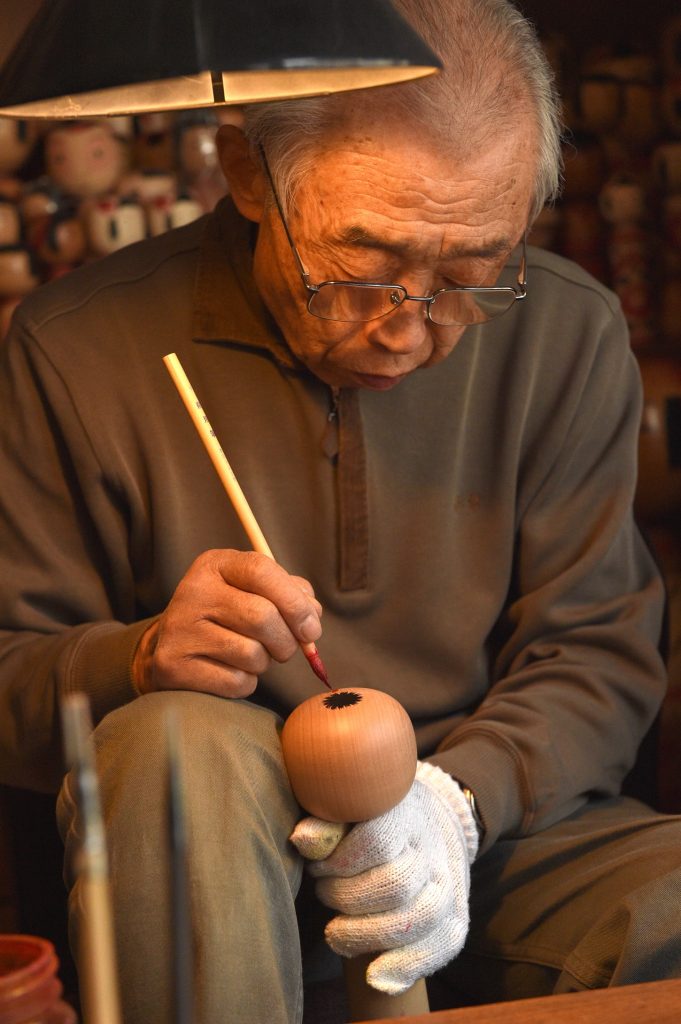
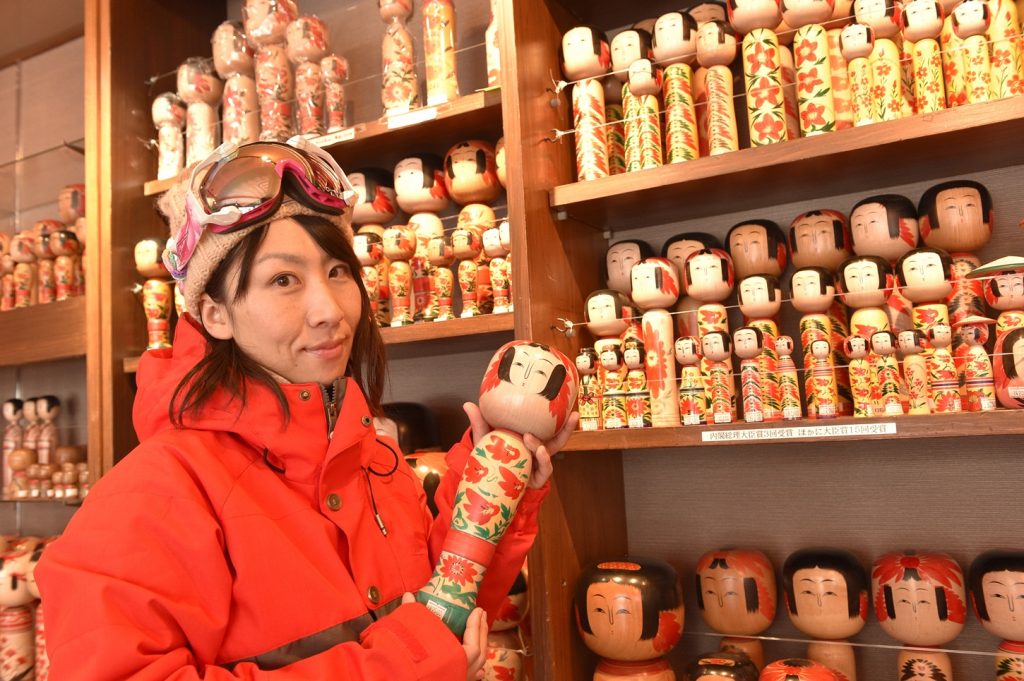
Accommodation
Zao Onsen has accommodation facilities of various sizes and styles. For example, Hot spring Ryokan is the best for those who enjoy relaxing time in Hot Spring, atmosphere WA taste. Accommodation within Ski slope is the best for those who enjoy winter sports mainly.
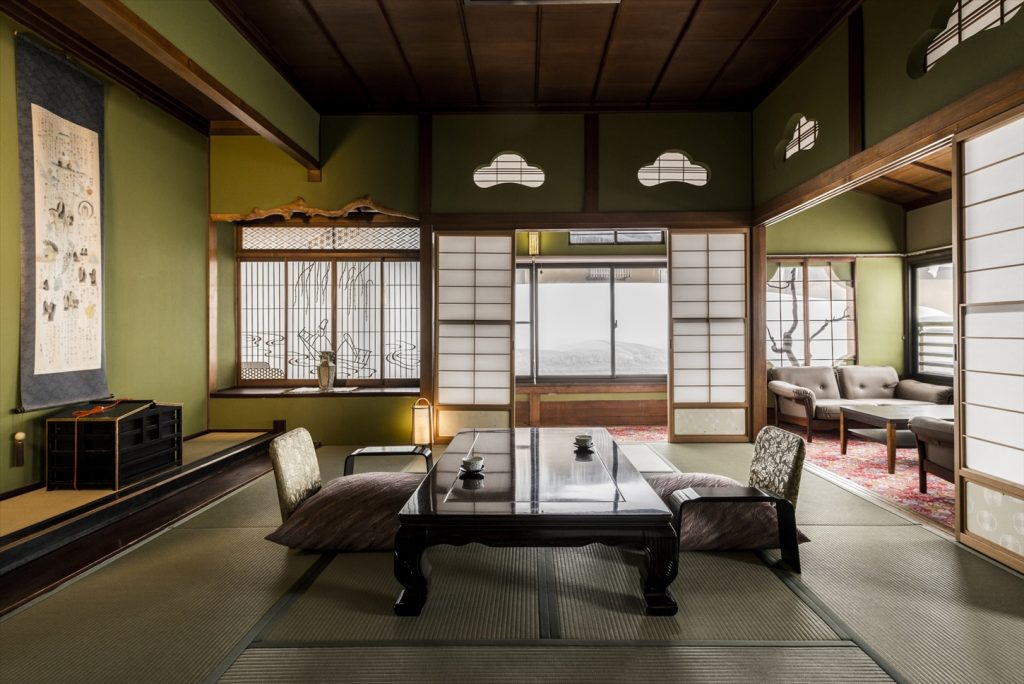
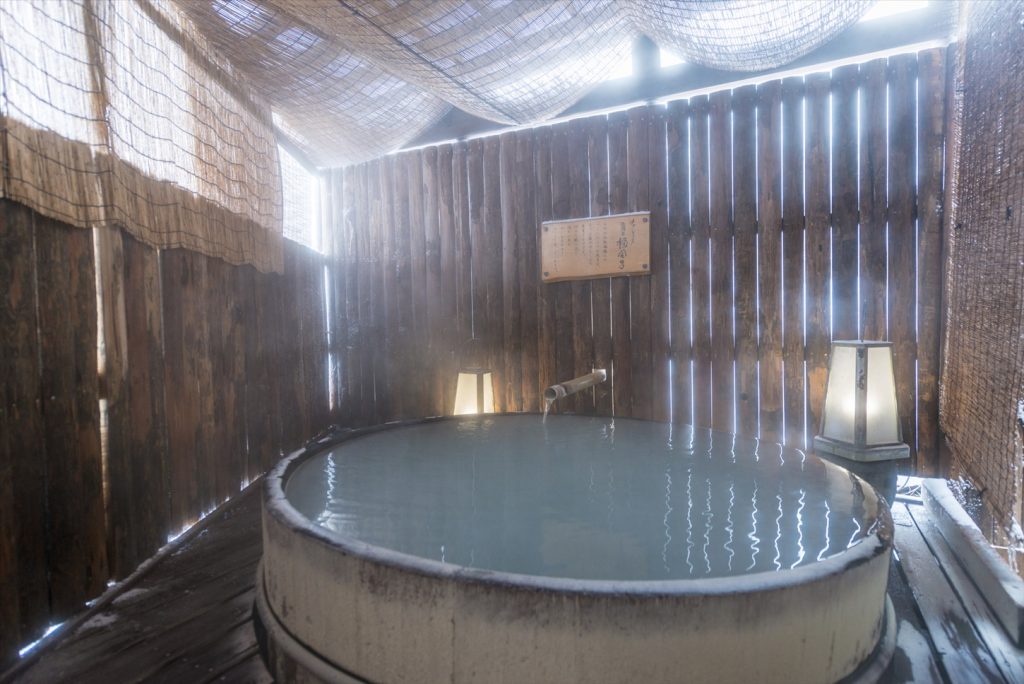
Local sake & wine of Yamagata
Yamagata is rice-producing and grape-producing area also, blessed with pure water and air, also famous as sake and wine product area.
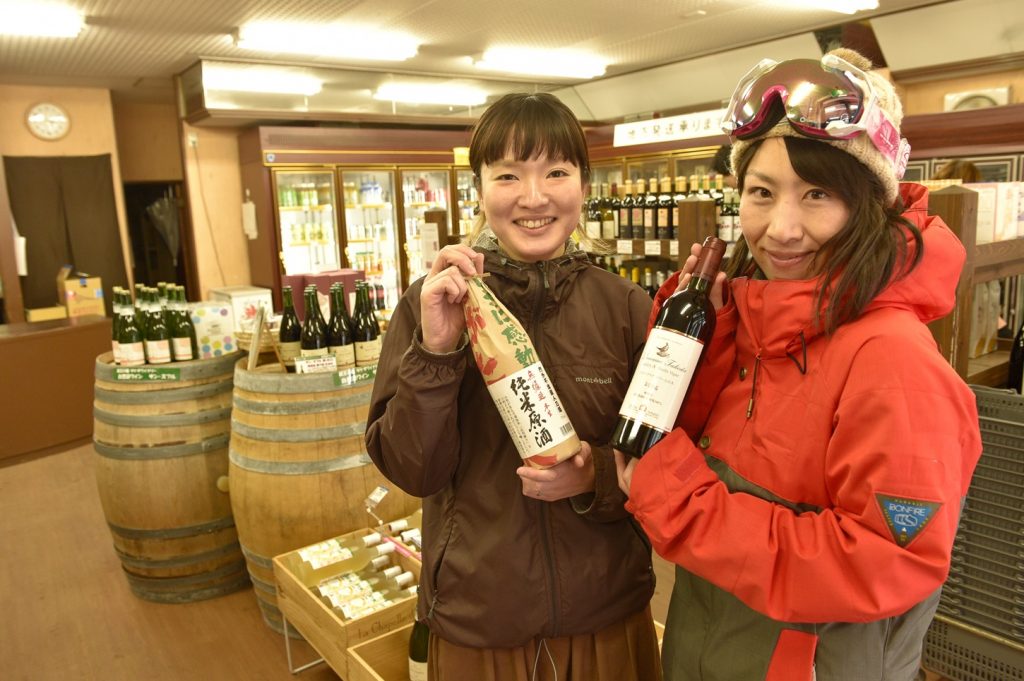
Tama Konnyaku
Tama Konnyaku is skewered round Konnyaku boiled with soy sauce, Yamagata product special. Excellent food to smell soy sauce and feel texture!! Yamagata’s soul food which you can eat in Hot Spring Town.
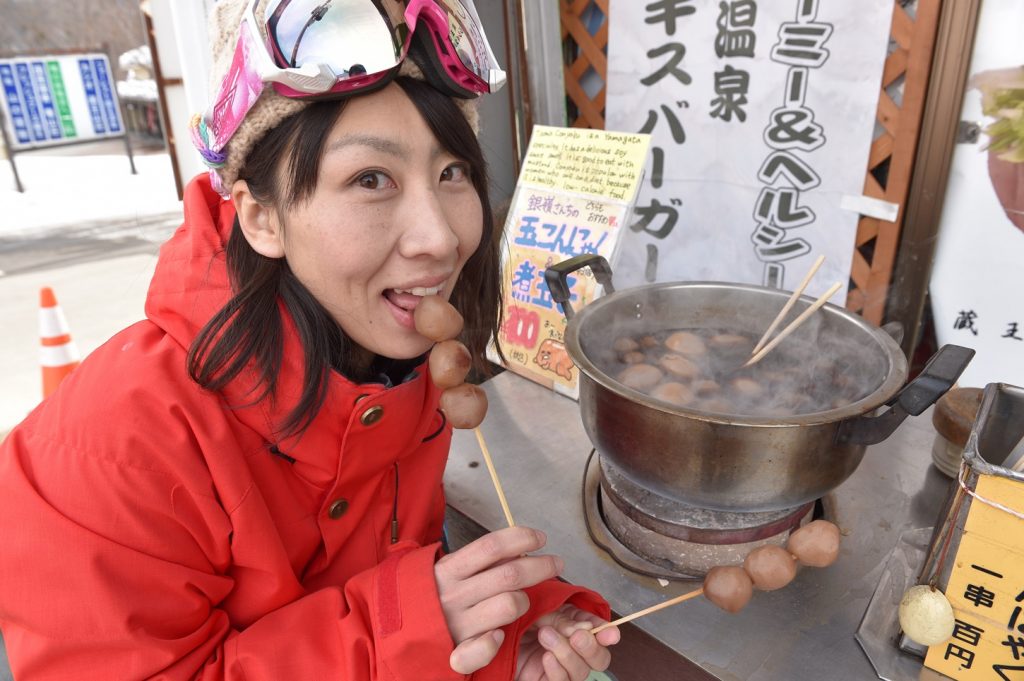
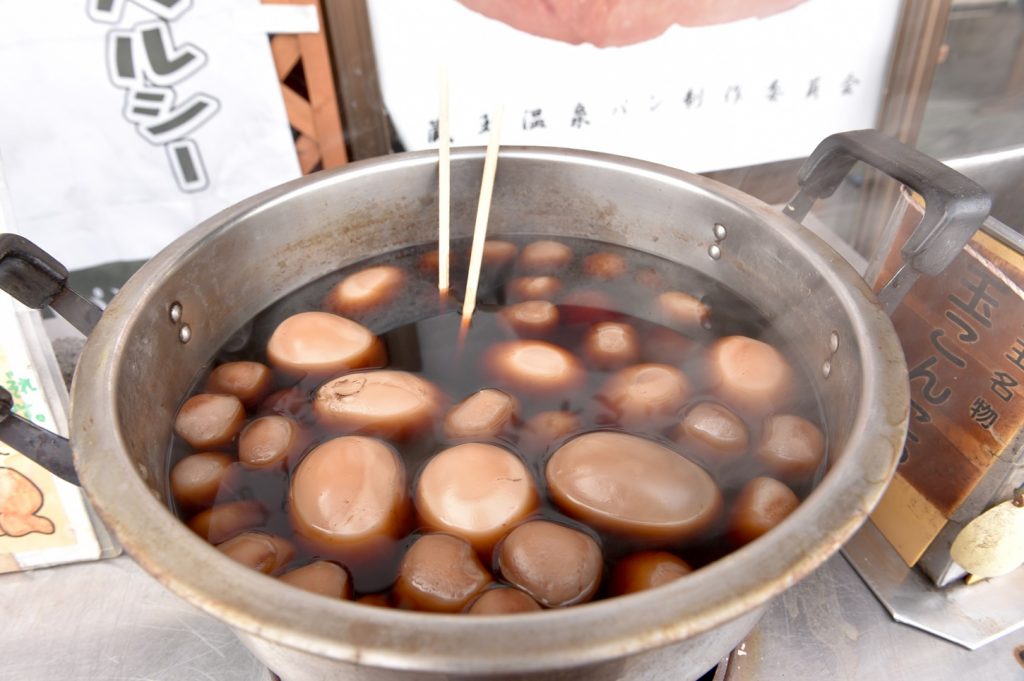
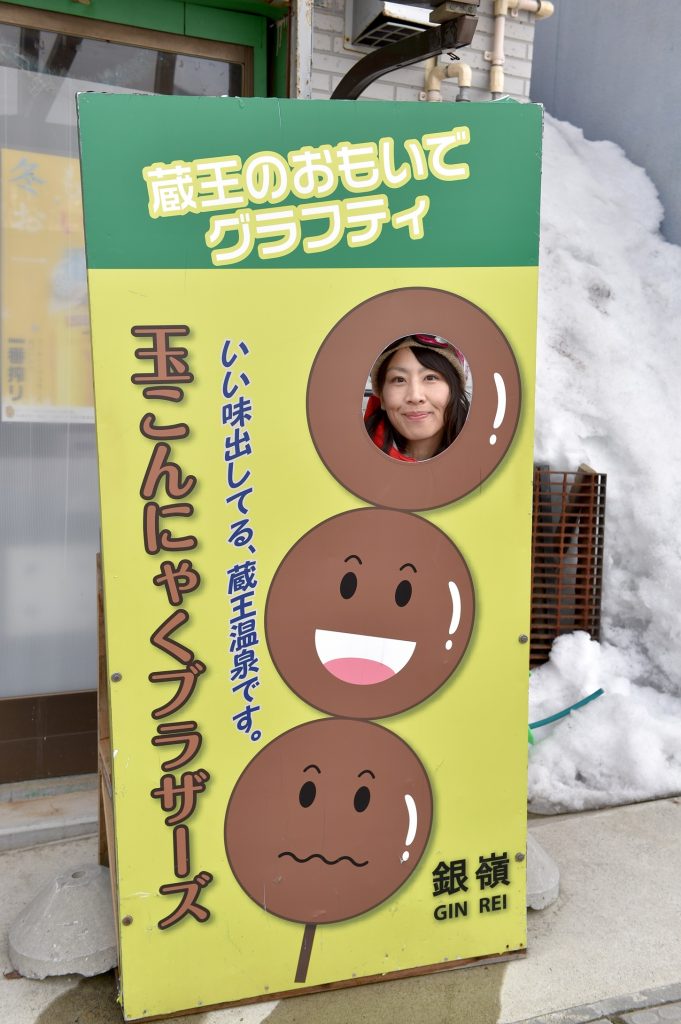
Jingiskan
Jingiskan, Japanese style Mongolian Mutton Barbecue, can be said as a signboard menu of the Zao Kogen. You can enjoy Jingiskan, using lamb meat of Surfcok type in the prefecture with special original sauce by each restaurant.
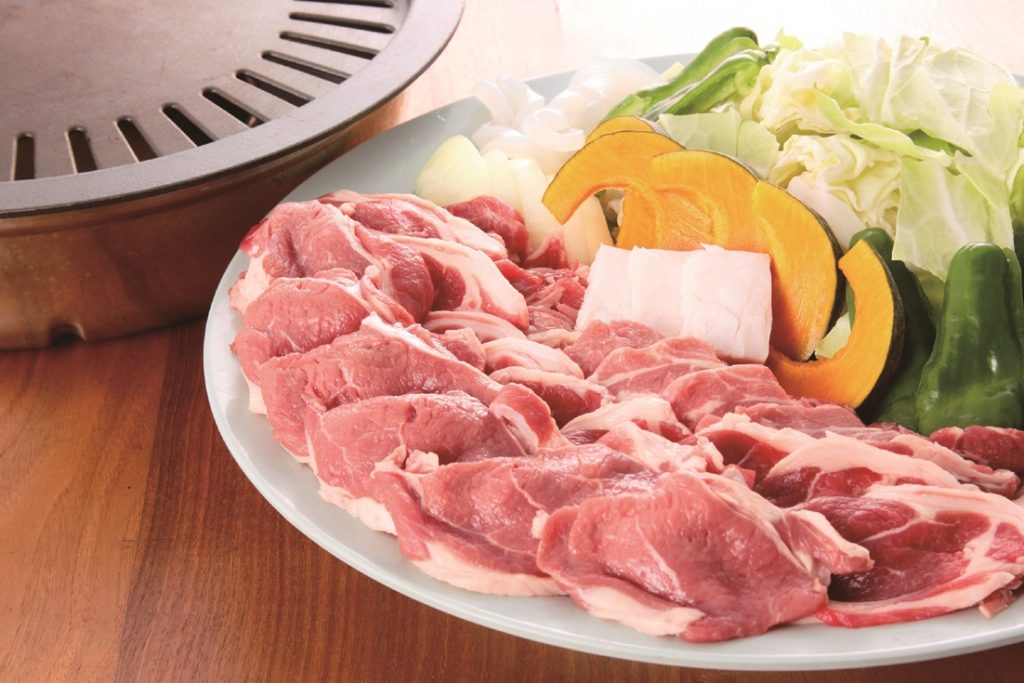
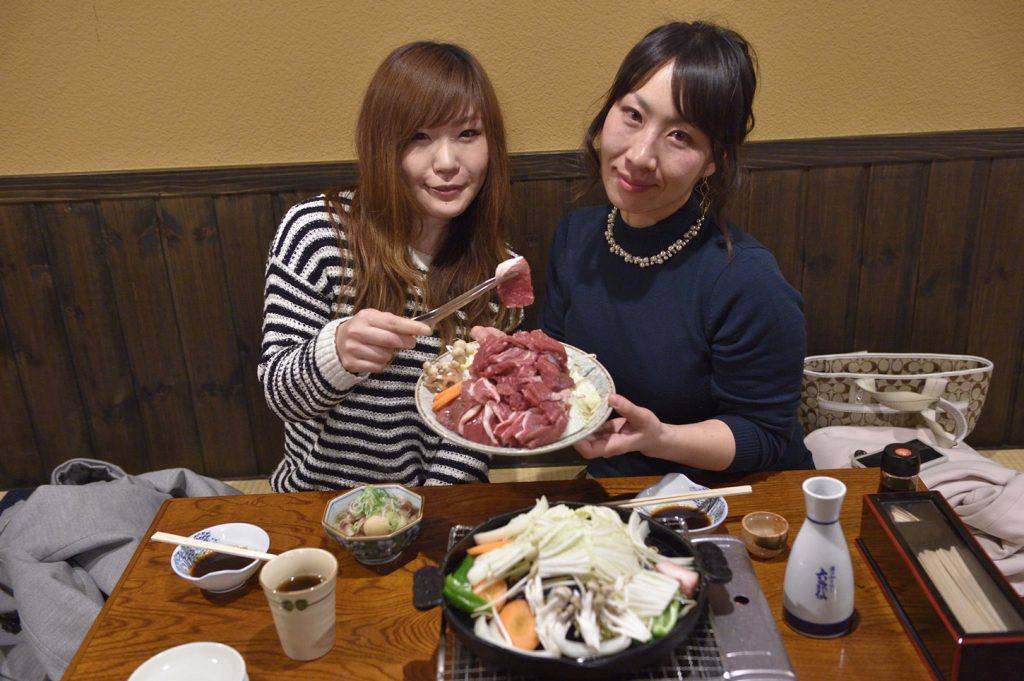
Yamagata Soba
Yamagata soba, which is characterized by Koshi and flavor as handmade noodles, is highly evaluated during buckwheat lover. There is also a soba shop offering handmade every morning to Zao Onsen town.
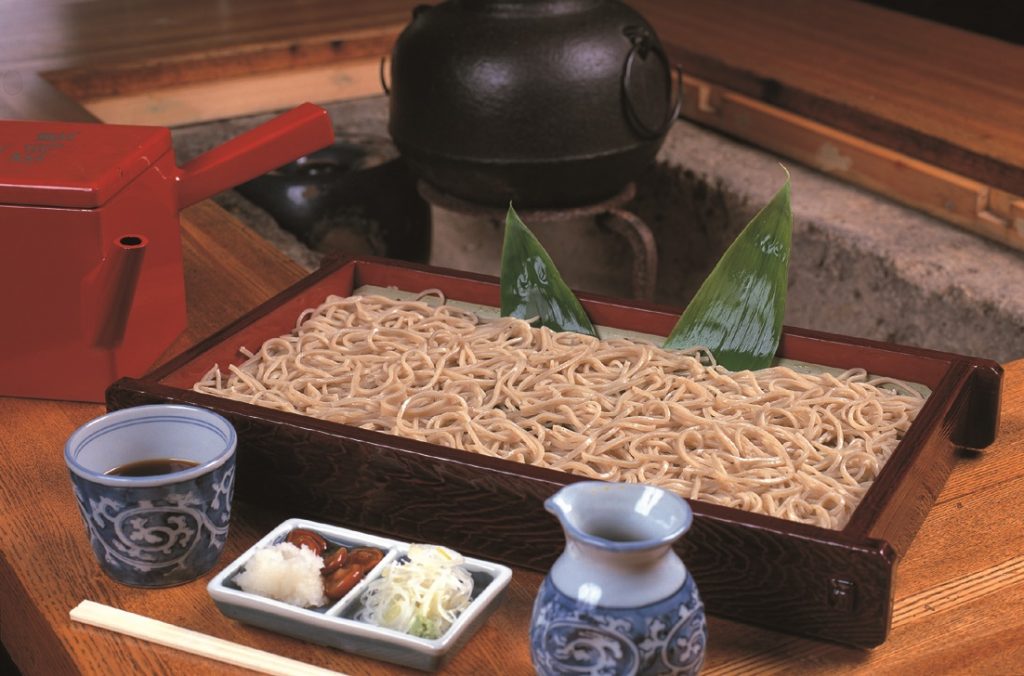
Yamagata Sake Museum & Yukemuri Bar Tsumami
“Yamagata sake museum” you can enjoy sake at the 49 breweries in Yamagata prefecture, which is highly valued in the world contest, and the interior with the motif of Edo modern and “Yukemuri-yatai Tsumami” which you can enjoy a reasonable local food are popular spot.
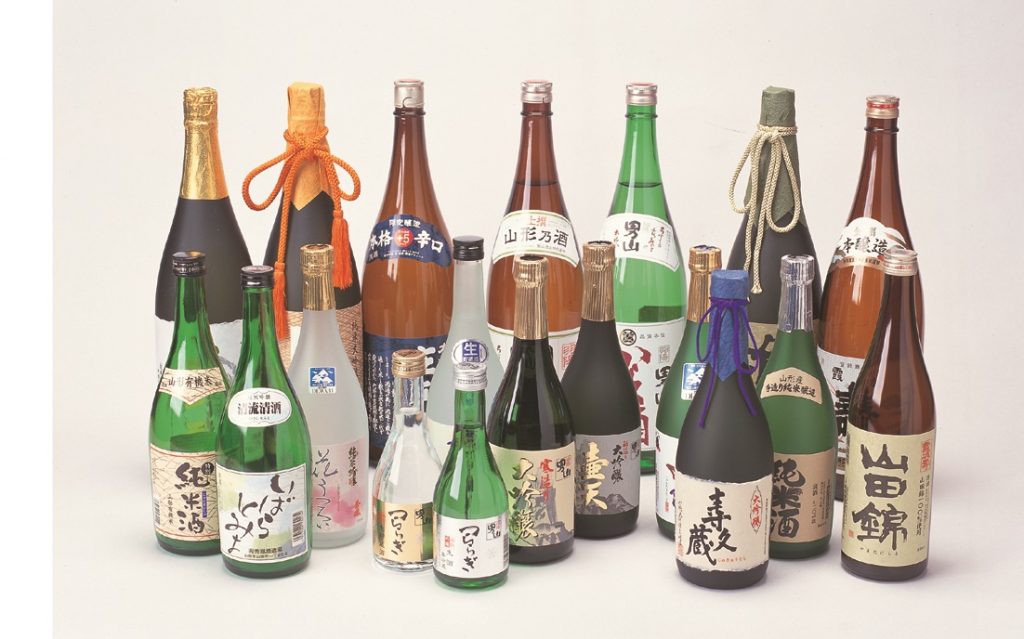
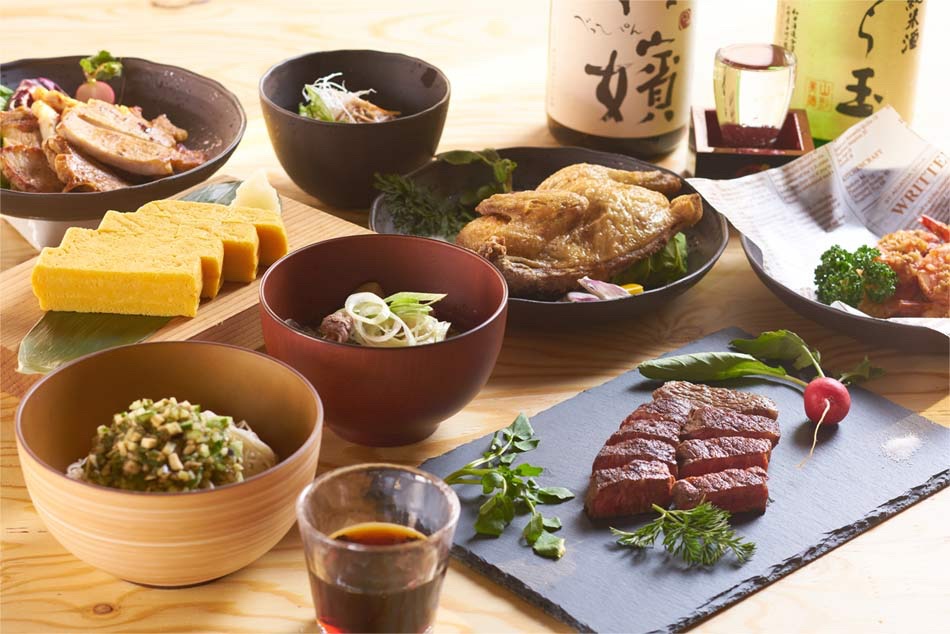
Zao Onsen Tourism Association
708-1 Zao Onsen, Yamagata-City, Yamagata 990-2301
Tel: (+81) 23-694-9328
URL:http://www.zao-spa.or.jp/english/
